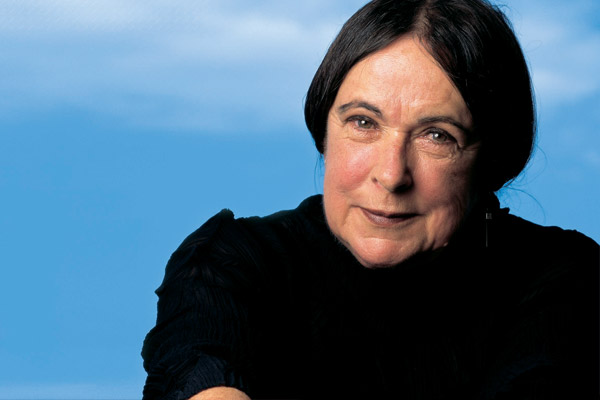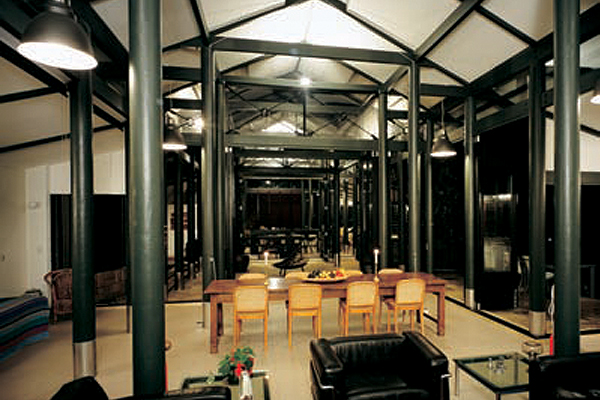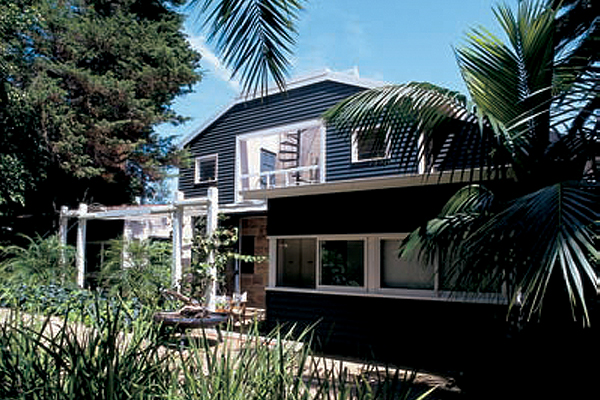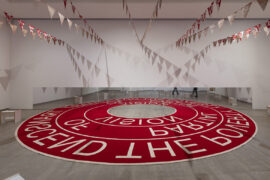Architect, scholar, teacher, writer and critic of international standing, Jennifer Taylor is almost without peer in Australia. An authority on contemporary architectural history, she is known for her rigorous academic standards, her passion for architecture and her generosity of spirit – a contribution that has been recognised in recent years through numerous prestigious awards.

April 22nd, 2014
Jennifer Taylor has already had a busy morning by the time we meet in the city apartment she shares with her partner, architect and planner, James Conner, overlooking Brisbane Botanical Gardens and Queensland University of Technology (QUT). With typical thoroughness, she has prepared information about her early life. With her trade-mark dark, centre-parted hair, she looks, according to architect Tone Wheeler (who was taught by her at Sydney University in 1974 and ’75, and then taught with her there from 1986 to ’97) exactly the same as she always did. “She has not altered, physically or intellectually, in the thirty years I have known her. That, to me, is the outward manifestation of her inner constancy. She still believes in humanism in architecture, which is really out of vogue right now. She is interested in the way in which architecture fits people’s lives.”
Taylor’s father was a Sydney doctor, and a cricketer for Australia, who suddenly abandoned his sporting career for a small medical practice in Far North Queensland. She remembers him as a strict, aloof, and enigmatic character who didn’t believe that girls should go to universities. “I’d always wanted to be a designer. I seemed to have a talent for it, but my father wasn’t particularly enamoured of the idea,” says Taylor. “Women were supposed to be in the kitchen. Your job in life was to be a good wife. He said he would send me nursing for four years to become domesticated. After that we’d re-consider whether I could go to university.” Taylor complied, married and went to live in England, where frequents trips to Europe engendered a life-long love for different places, people and cultures. Asked whether her father’s chauvinism might have fuelled her professional ambition, she just laughs. “No, not at all. He died before I did architecture. I was quite independent by that stage.”
Her initial interest in design was sparked by the houses she grew up in – an archly modern house in Beaudesert, Brisbane, “by quite a well-known architect called Blanche” and a lovely big Queenslander in Southport. In Oxford in 1960, bored with nursing, she applied to the local Polytechnic, hoping to do interior or graphic design. “It never occurred to me to do architecture – it was always a man’s field.” She was interviewed by the principal, Reginald Cave, and questioned about her background. “Then he asked me to arrange some blocks and said: ‘You can start architecture on Monday!’ I would never have got in normally; there were pre-requisites to the course that I didn’t have. But someone had pulled out. It was the greatest fluke of my life,” she says. “It was unbelievable, absolutely!”
Moving to America in 1963, she continued studying and excelled. “You do well in things that you really love,” she says. She completed her degree with Honours and received the Architecture Association Gold Medal at the University of Washington in Seattle, in 1967, and a Master of Architecture, in History in 1969. She also took a course there on the contemporary Japanese house and garden by Professor Teiji Ito, which led to a fascination with Japanese design.
She had also had two children by this time and, returning to Sydney in 1970, needed to find work that would accommodate the needs of a young family. “Another fluke in my life was that I walked straight into Sydney University when there was an opening teaching contemporary architectural history.
Peter Johnson (Dean of Architecture between 1967 and 1988) “not only gave me the position, but supported me enormously.” Taylor describes Johnson, a principal of McConnel Smith and Johnson, as a visionary and a mentor – “a wonderful architect – just the greatest kind of Renaissance man.” He helped her establish new courses and arrange funding for her programs, introduced her to people and opportunities, encouraged her to start publishing and assisted with her books. Taylor honoured him with an oration at the memorial service after his death in 2003.
The other man Taylor credits as playing a major role in her career is acclaimed Japanese modernist architect, Fumihiko Maki, whom she first met when she visited Tokyo in 1975, (on the first of two Japan Foundation Professional Fellowships). Already an eminent architect, Maki was appointed Taylor’s mentor. “With him looking after me, all doors were open to me,” she says. “He’s been wonderful to me all through my time in Japan.” From initially looking at contemporary gardens, she says, “I became very interested in contemporary architecture in Japan. I loved it. I just kept going back. I started writing on Japan. I have been influenced, unquestionably, by Japanese work.” Her most recent book is The Architecture of Fumihiko Maki: Space, City, Order and Technology, published in 2003.
Architect, Howard Tanner, who also lectured with Taylor at Sydney University in the 1970s, says: “Academics are supposed to do research and produce worthy papers, but of all the people I can think of around the architectural scene in the ‘80s and ‘90s, she was possibly the one who was really doing it.” From her first book, in 1972, An Australian Identity: Houses for Sydney 1953-63, she progressively assessed Australia’s recent architectural history and produced, in 1982, a broad national picture, Australian Architecture since 1960, which she describes as a book that had to be written. Her concern for appropriate conservation, particularly of mid-20th century tall city buildings, led to work with the Heritage Commission and further publications.
She was also writing on contemporary architecture in Japan, Asia and the South Pacific. Invited to contribute a chapter on Australia and Oceania in Banister Fletcher’s History of Architecture – which Taylor calls “the bible” of architectural history – she went on to produce the Oceania section in World Architecture 1900-2000, A Critical Mosaic. In researching these, she says, “It made me realise that virtually nothing had been written on the region.” As a result, she is currently producing, in conjunction with Conner, a history of South Pacific architecture, 1900-2000. “It’s the hardest book I’ve done in my life,” she says, because “no-one keeps any records. The plans are thrown out; even for buildings like parliament houses the drawings dry out in the heat and crumble to dust.” Fascinated by the work and lured by the challenge, she says, “Someone had to do it.” Like her other books, and the way she teaches, the South Pacific book will be based around themes drawn from studied analysis of her subject rather than chronological listings.

‘Dunbar’, Stradbroke Island, 2000.
Through nearly 30 years as a lecturer and Associate Professor at Sydney University, Taylor inspired generations of architects she taught and taught with. “She was the most scholarly lecturer that many of my colleagues and cohorts of students ever encountered,” says Wheeler. “She had this incredible enthusiasm for architecture and the scholarly knowledge to back it up. It opened up a whole new world to me and many others.”
Tanner tells how “she was continually researching, then setting up new courses about that research,” citing conservation and heritage issues as a fledgling field that he and Taylor pioneered in the 1970s. More recently, she has consulted to the Australian Heritage Commission on numerous occasions and is currently an assessor for the Queensland Heritage Council.
She was the first to establish an architectural dialogue with Asia, bringing leading Japanese and Chinese figures here to lecture, travelling and lecturing there herself, long before it seemed obvious to do so. “God, she helped me,” says Tanner. “She established wonderful standards in the teaching area. So, I’m very grateful to her for that. If fate had been kinder to her she would have ended up being Professor of Architecture at Sydney University.” Wheeler goes further: “She was treated shabbily. Everybody recognised her as the pre-eminent historian and theoretician – and if there wasn’t a professorship, a chair should have been created for her. She is of that stature.”
Taylor left Sydney University in 1998 for the Queensland University of Technology in Brisbane where she is Adjunct Professor. According to long-time friend, architect Louise Cox, she is much happier there. While Taylor is much admired as a writer and speaker, delivering her lectures with great passion and precision, Cox believes her greatest legacy is the students she has taught. “When you’re at university, you’re lucky to get one decent person to teach you. That lot of students were very lucky to have Jennifer and I don’t think they’ll ever forget her.”
“I do feel close to the students,” says Taylor. “The greatest thing about teaching is to be able to pass on knowledge to people that you’re close to, people who are going to take it and develop it for themselves.” Those people are spread far and wide. Along with many trips to Japan, she has travelled extensively in South-East Asia, Europe, Scandinavia and the USA, and also to China, Egypt, India and Sri Lanka and Latin America, attending conferences, delivering papers and lectures and conducting research and study tours. She has been a Visiting Professor at several American universities as well as in Hong Kong, Vietnam and New Zealand. “I’ve done a lot of that, she says, “because I love that too – meeting a whole lot of different students and new challenges.”
Stella de Vulder, from the Australian Architecture Association (AAA) also praises Taylor as a strong supporter of industry endeavours – events, seminars, conferences and talks – who serves on many award and competition juries. “She’s chaired conferences, where she’s even developed the program. She doesn’t stint with her knowledge and she doesn’t play games. She’s a straight shooter, very generous and always gracious.”
In 1998, Taylor was honoured with the inaugural Royal Australian Institute of Architects (RAIA) Marion Mahony Griffin Award for writing and teaching – and again, in 2000, with the inaugural RAIA National Education Prize. In 2003, she was made a Life Fellow of the RAIA. “These were given to me by the profession in Australia. They’re very personal and that’s very important to me.”
In 1999, she received an Honourable Mention in the International Union of Architects (UIA) Jean Tschumi Prize for Architectural Criticism and Education, which was awarded in Beijing. Then in 2002, she was awarded another Honourable Mention in the Jean Tschumi Prize, a joint tribute conferred on the authors of World Architecture – A Critical Mosaic.
Taylor has designed several buildings through the course of her academic career. Her 1994 house at Palm Beach in Sydney was awarded a CHASA (Committee of Heads of Architecture Schools Association) Design Citation. In 2004, ‘Dunbar’, the house she and James Conner designed for themselves on North Stradbroke Island, won ‘House of the Year’ in the Brisbane region and the Residential Award in the RAIA Queensland State Awards.

House at Palm Beach by Jennifer Taylor.
In ‘Dunbar’, Taylor has brought together ideas she has developed over many years about creating architecture that expresses its place, time and culture. “Australia must recognise where it is in the world,” she says. “We probably have the richest mixing pot of anywhere in the world. We have European heritage, Aboriginal heritage, South-East Asian heritage and South Pacific heritage, and it seems to me that out of this should grow a wonderful and special architecture.” While she believes Australia is moving in this direction, it has not yet arrived. For her this is not done self-consciously, she says, “but I do so much work in Asia and the Pacific now that it does influence my thinking”.
With ‘Dunbar’, Taylor’s intention was to create an immersive environment through an architecture that emanates from place, specifically a ‘beach house’. She also wanted to challenge conventional notions of house design and construction. Designing for climate, and for tropical conditions in particular, had long been of interest. “I’ve always been teaching that the building and its context are an entity which needs to be conceived as a totality from the beginning.” Moreover, “To celebrate nature, to my mind, is incredibly important.”
This, in turn, implies a further position: “As our time spent with machines and technology, increases, our time for all the wonderful ‘ings’ of life decreases – things like loving and thinking and swimming. You can’t make more time, but my belief is that you can intensify the experience by making people more aware of their environment.” To intensify that awareness at ‘Dunbar’, two pavilions are linked by a large, partly open roofed courtyard “so you’re conscious all the time of where the sun is; you are conscious of a storm approaching; if it’s raining; if there’s brilliant sun; if the wind’s driving you mad. It has very light enclosure so that you get more of the smells of the salt and the trees, more of the sounds of the birds, so this amplifies these experiences. And all these encounters are wonderful for human existence.”
Despite – or perhaps because of – the breadth of Taylor’s contribution to architecture, she maintains that “being a woman” is her greatest achievement. “Because being a woman is the best thing to be,” she says, “other things are secondary. Not all women have been as fortunate as I have. I have been very blessed. I’ve been in a very privileged position to be able to communicate and to hand knowledge on.”
The idea of contribution is an important one for Taylor – contribution to the profession, to academic standards, to students, to contemporary architectural history, and to the experience of place and culture through architecture. “Maybe I feel I can contribute more through books than I can through buildings, but I’d like to do more of both,” she says. “I believe in living life to the full.” Given the sustained impact she has achieved in so many different ways, it is surely the profession that has been privileged by Jennifer Taylor, rather than the other way round.
Portrait by Anthony Browell.
Jennifer Taylor was featured as a Luminary in issue #20 of Indesign, February 2005.
INDESIGN is on instagram
Follow @indesignlive
A searchable and comprehensive guide for specifying leading products and their suppliers
Keep up to date with the latest and greatest from our industry BFF's!

A longstanding partnership turns a historic city into a hub for emerging talent

Welcomed to the Australian design scene in 2024, Kokuyo is set to redefine collaboration, bringing its unique blend of colour and function to individuals and corporations, designed to be used Any Way!

For Aidan Mawhinney, the secret ingredient to Living Edge’s success “comes down to people, product and place.” As the brand celebrates a significant 25-year milestone, it’s that commitment to authentic, sustainable design – and the people behind it all – that continues to anchor its legacy.

Congratulations to Kerstin Thompson, 2023 recipient of the Australian Institute of Architects’ Gold Medal. We revisit Kerstin’s many accomplishments, among them being named an INDESIGN Luminary.

As NGV’s top design curators, Simone LeAmon and Ewan McEoin have big dreams for the design sector. And they’re coming at it with energy and ambition.
The internet never sleeps! Here's the stuff you might have missed

‘Breathing Helps’ is a major solo exhibition bringing together Nolan’s large-scale works with new commissions and performances.

Whether you’re an architect, interior designer or student eager to learn, the 2025 Design Discussion series at Saturday Indesign will inspire fresh perspectives. Check out the schedule now!